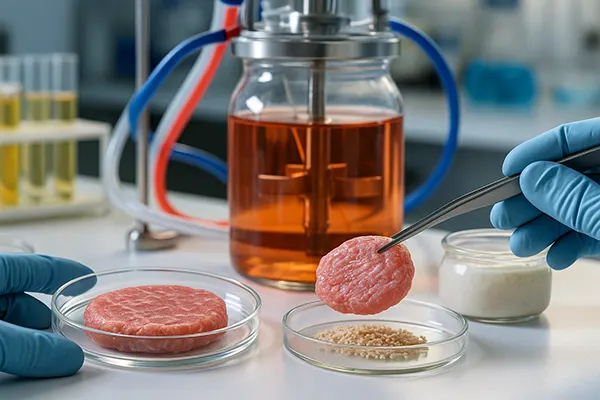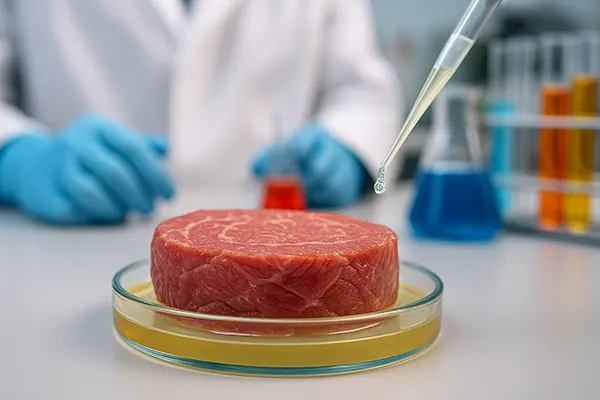
Synthetic Food and Cultivated Meat: Why 2025 Has Become the Year of Mass Adoption
By 2025, synthetic food and cultivated meat have shifted from niche scientific projects to widely available consumer products. The sector has grown rapidly due to advances in bioprocessing, falling production costs, and new food regulations across the EU, UK, USA, Singapore and Israel. These products are no longer viewed as experimental alternatives but as stable items of everyday consumption supported by large-scale manufacturing and transparent quality standards.
The Technological Drivers Behind Mass Production
Mass adoption in 2025 has been enabled by major breakthroughs in cellular agriculture. Growth media based on plant-derived amino acids and recombinant proteins have replaced expensive serum components, radically reducing production costs. Bioreactors designed specifically for food-grade cell growth enable consistent yields and allow companies to scale production without compromising quality.
Another fundamental factor is the improvement in cell line stability. Research teams in Europe and Asia have developed robust strains of animal cells with predictable growth patterns, making the manufacturing process more efficient. These innovations have allowed producers to reach the volumes required to supply supermarkets and large food retailers.
Parallel improvements in precision fermentation have expanded the synthetic food sector beyond meat. Dairy proteins, fats and egg components can now be produced with high nutritional accuracy. This has accelerated the shift from experimental batches to international distribution networks capable of supplying millions of consumers.
Cost Reductions and Their Impact on Accessibility
The cost of producing cultivated chicken and beef equivalents has fallen by up to 70% since 2022, according to publicly available industry reports. Large-scale facilities in the Netherlands, the United States and Israel have reached a point where production aligns with mid-range retail pricing. As a result, cultivated products in 2025 are no longer marketed as premium items but as cost-stable alternatives to conventional meat.
Improved energy efficiency also contributes to lower prices. Companies have introduced bioreactors that optimise oxygen transfer and reduce waste heat, lowering operational expenses. This makes the industry less dependent on specialised energy sources and more resilient to fluctuations in supply chains.
Wider accessibility is strengthened by partnerships between producers and established grocery chains. These agreements ensure that cultivated meat reaches consumers in ordinary retail settings rather than exclusively through specialty distribution. This shift has normalised synthetic food, making it a routine part of household shopping behaviour.
Regulation, Food Safety and Public Confidence
The regulatory landscape in 2025 is more defined than in previous years. The UK Food Standards Agency, the European Food Safety Authority and regulators in the US and Singapore have introduced comprehensive frameworks covering bioprocessing, labelling, microbial safety and allergen management. These frameworks ensure that cultivated products adhere to transparent standards comparable to traditional food safety systems.
Mandatory reporting of production methods plays a key role in building public confidence. Producers must document cell line origins, growth conditions and quality controls, which are reviewed before a product reaches retail shelves. This clarity helps consumers make informed decisions and reduces misinformation about synthetic food technology.
Independent audits and disclosure of nutritional composition have become industry norms. These measures enable consumers, healthcare professionals and researchers to assess the properties of cultivated foods with precision. The inclusion of this information on packaging strengthens trust and positions the sector as a reliable part of the modern food economy.
The Role of International Standards
International standards developed through collaboration between EU agencies, UK authorities and global organisations such as the Codex Alimentarius Commission have unified safety criteria. They ensure that cultivated foods produced in one region meet comparable quality requirements in another, simplifying global distribution.
This alignment also encourages investment. Manufacturers can design facilities that comply with multiple jurisdictions, reducing the cost of adapting systems for export. It has encouraged new players from Asia, North America and Europe to enter the market, further accelerating innovation.
As more countries adopt shared regulatory frameworks, the industry benefits from consistent expectations. This reduces uncertainty for producers, helps maintain stable prices and allows consumers to trust that cultivated items meet internationally accepted food safety measures.

Environmental, Social and Economic Implications
Synthetic food and cultivated meat offer measurable environmental advantages in 2025. Peer-reviewed studies indicate reductions in land use, water consumption and greenhouse gas output when compared with conventional livestock production. These benefits have contributed to policy incentives in several regions, including funding for sustainable protein research and support for low-emission food production technologies.
The sector also brings new economic opportunities. Facilities require specialists in biotechnology, quality assurance, food engineering and supply chain management. This diversification supports regional development and creates high-skilled employment in areas transitioning away from traditional agriculture or heavy industry.
Social attitudes have evolved significantly. While early discussions were dominated by scepticism, consumers in 2025 value the transparency and traceability of cultivated products. Clear information on origin and production methods reassures households and aligns with growing interest in reliable and ethically produced food.
How Cultivated Food Shapes the 2025 Market
By 2025, cultivated chicken, beef and seafood have secured a competitive position in retail markets, appearing alongside conventional products. Consumer surveys across the UK and EU show that availability, transparent labelling and stable pricing play a decisive role in adoption, while taste profiles have been refined to match traditional options.
Food service providers are incorporating cultivated meat into menus as part of a broader focus on resource efficiency. Restaurants and catering organisations select these products due to predictable supply levels and consistency in nutritional quality, which supports operational planning.
As distribution networks expand, synthetic food is transitioning from novelty to standardised product categories. This trend is reinforced by ongoing research that aims to broaden the range of available items and reduce the environmental footprint of production even further.